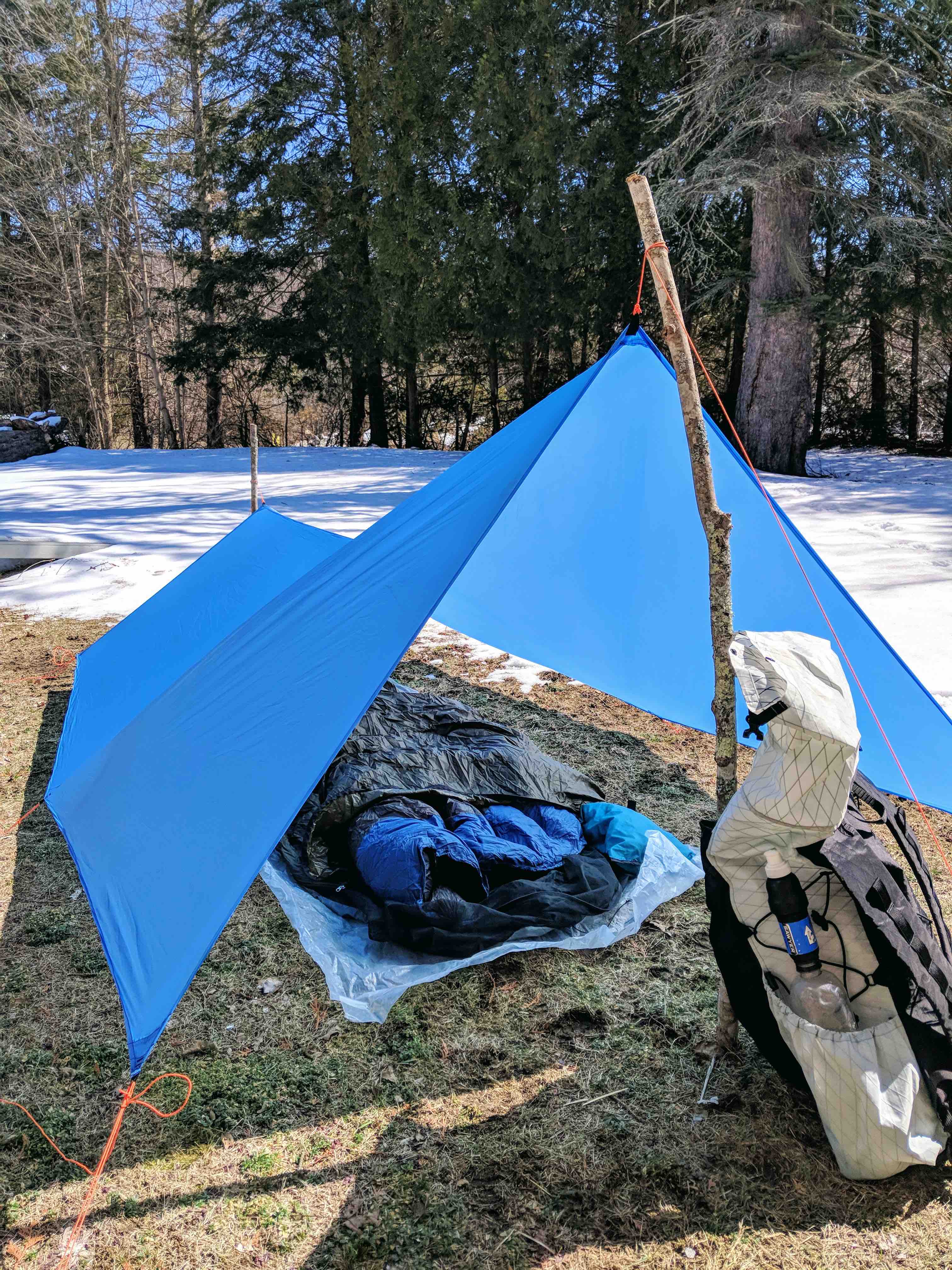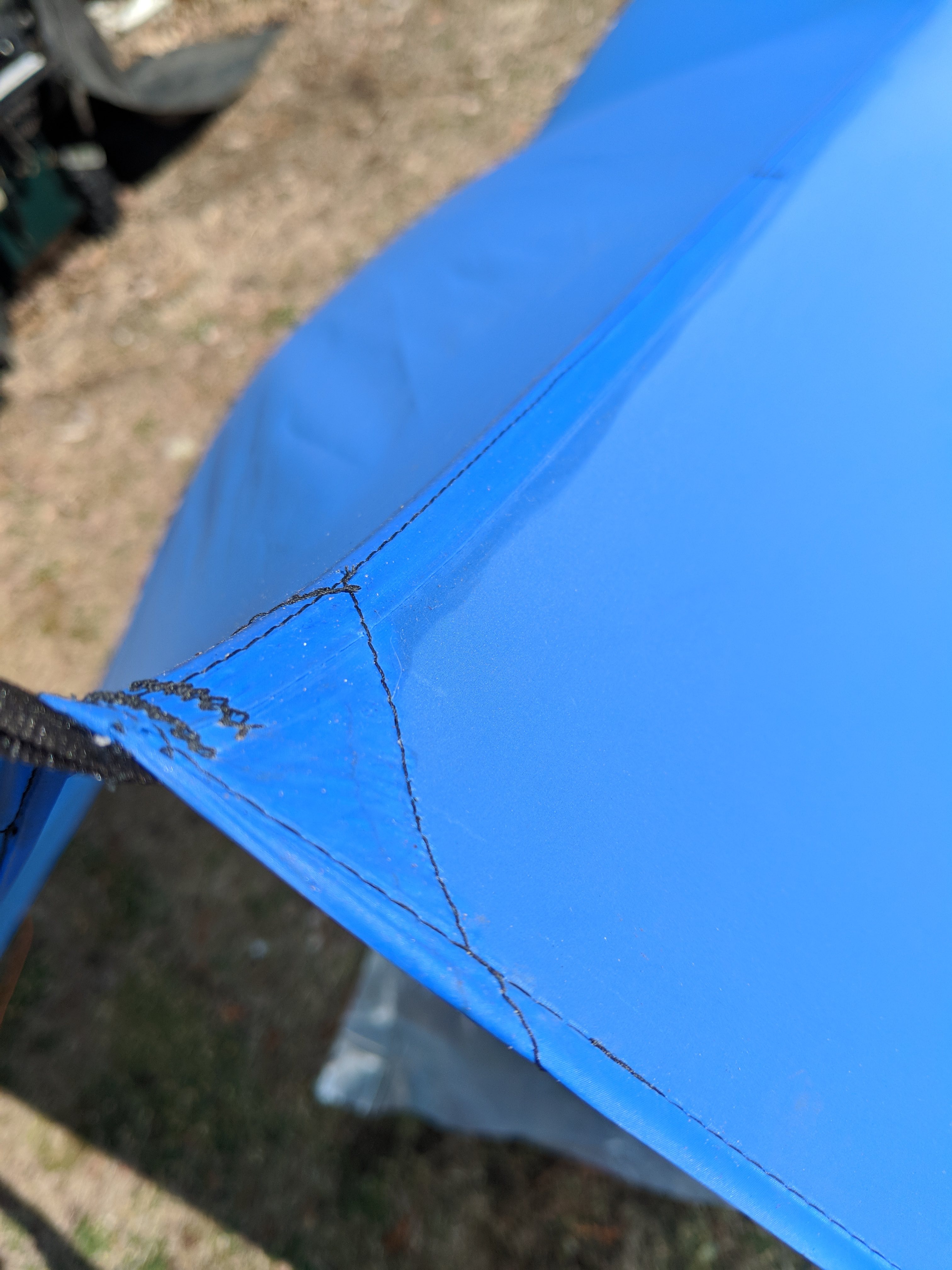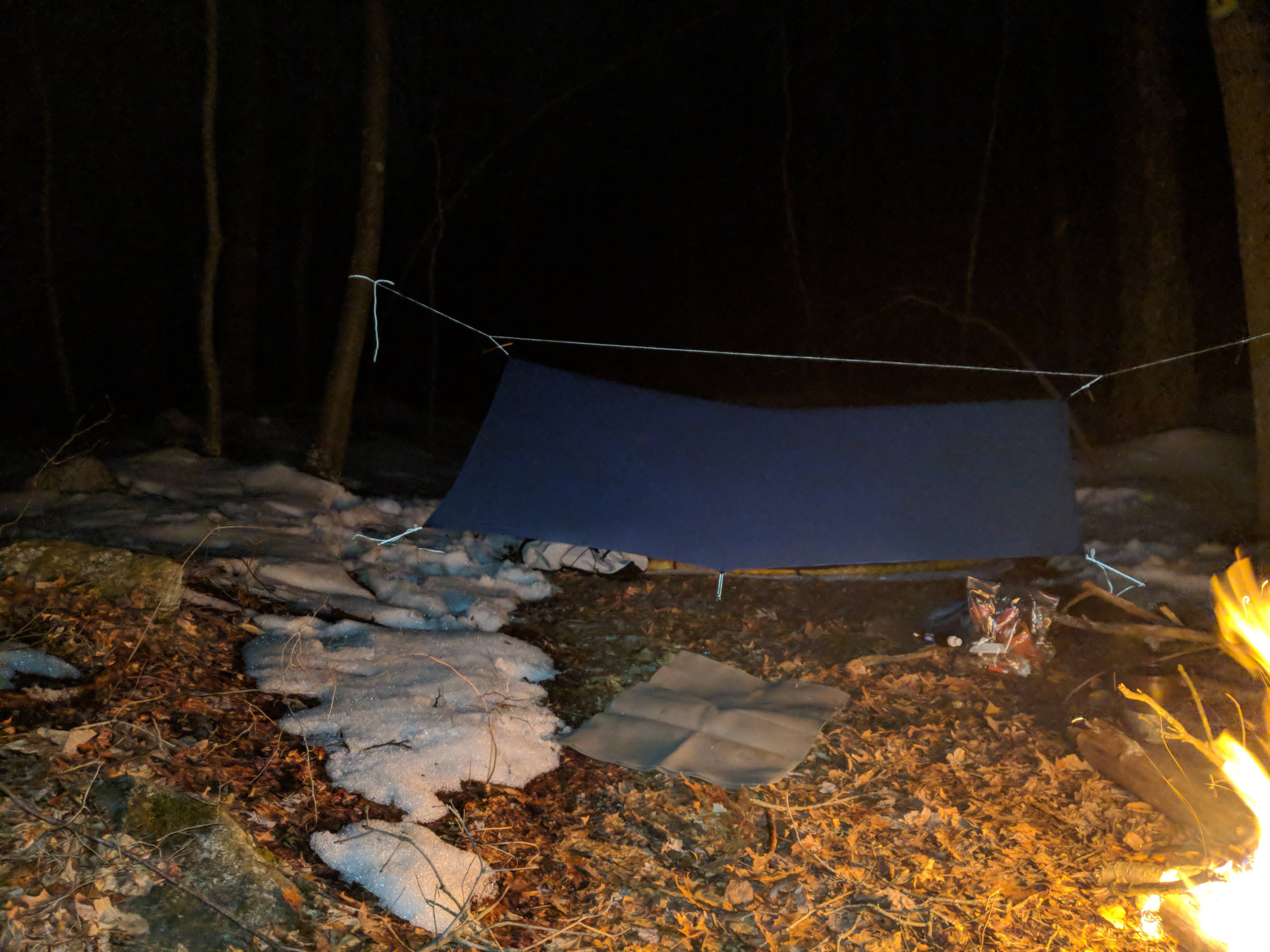Topic
MYOG tapered tarp 8' x 6' x 9' with MEMBRANE Silpoly
Forum Posting
A Membership is required to post in the forums. Login or become a member to post in the member forums!
Home › Forums › Gear Forums › Make Your Own Gear › MYOG tapered tarp 8' x 6' x 9' with MEMBRANE Silpoly
- This topic has 12 replies, 7 voices, and was last updated 6 years ago by
 Eric Peterson.
Eric Peterson.
-
AuthorPosts
-
Mar 26, 2018 at 6:02 pm #3527197
Wanted to share my first sewing experience and thoughts on Ripstop By the Roll’s 0.93 Membrane Silpoly in a tarp application. I’ve been a longtime lurker on these forums and admirer of all the great MYOG posts and information these boards have to offer. Finally, I committed to making my own tarp. This project was spurred on by a desire to break out of my comfort zone and away from my well-trusted single-wall tent. I find myself drawn to the flexibility of a tarp/bivy combo and the challenge of using it in a more humid/rainy temperate environment (New England).
The design for this tarp was simple, an 8’x6’x9′ trapezoid without cat cuts. My hope was to make this a design with the possibility of more pitches than an A-frame, but with the utilitarian shape of a tarp like the MLD Grace. I reasoned that leaving out the cat cuts would lead to a more flat-tarp feel. I haven’t had the opportunity yet to test other pitches extensively. However, in the future I’d likely use cat cuts with a material that stretches as much as this. The finished tarp + lines weighs 8.0oz.

Material, from RSBR:
6yards MEMBRANE Sipoly, Glacial Blue, claimed HH of ~2000mm and 0.93oz/yd2 finished weight
¾ grosgrain ribbon
3/8 grossgrain ribbon
Gutterman MARA 70 thread
After receiving the material and running a few test stitches, I laid out the fabric on my floor and drew out the two identical panels using a tape measure, 8ft planed board as a straight edge and a dressmaker’s pencil. Then cut my panels with Fiskars fabric shears (would highly recommend as budget scissors) and checked the uniformity of the panels. A few discrepancies, but nothing more than a ¼” which isn’t too bad.
The tarp was constructed of 2 identical trapezoidal panels measuring 108” along the a straight line in the y/height direction, and a bottom of 36”, top of 48” along a straight line in the x/width direction. The straight 108” edges were aligned and clipped together using office bulldog clips. These aren’t the best and can be finicky to use but have plenty of holding power and don’t slip on this silpoly.
The ridge was stitched together using a hybrid french seam.

Then, small reiforcement patches were made out of scrap. First I cut cardboard templates for each corner, sizing the patches as 5” along each the two edges of the tarp’s corner. Then templates for the midpanel tie outs as isosceles triangles with 5” edges. I then cut 4 of each out of scrap fabric and hemmed them on the edge(s) that would not be incorporated into the final rolled hem.
The corner reinforcements were sewn on with parallel lines of straight stiches 0.5” apart

The midpanel reinforcements were sewn with a single line of stiches around the “inside” 2 edges of the patch triangle. Originally they were sewn on with “parallel lines” as with the corner patches. However, this was re-done because my sewing technique caused the patches to “walk” and become off-center. The edge-sewing method allowed me to center the patches better.
After all reinforcement patches were sewn in place, I gave the tarp a 3/8” rolled hem around the perimeter to finish the main tarp body. Notice how the ridgeline tie out is sewn on.

Lastly (so I thought) I made 8 identical tie out loops and bar-tacked them on with 3 rows of stitches.
Of course, on the LAST TWO snips of loose thread, I managed to cut a hole in one of the worst imaginable spots. As frustrating as this was, it was a great learning experience. Firstly, don’t rush at the end. Secondly, bonded patches with 100% silicone (GE Silicone II) work great with this material.

To remedy this screw-up, I removed the grossgrain to obtain a flat area to re-reinforce. I then cut mini triangles using the carboard template I’d made previously. These I bonded, top and bottom by smearing with undiluted silicone and placed just inside the rolled hem stitching. Then the area was weighed down after being sandwiched between two pieces of parchment paper, then two pieces of evazote foam (to help distribute weight across the uneven thickness of the stitched/hemmed fabric).

This completely sealed and added strength to the area where I’d cut the hole. I’ve used this technique before to repair tents made of 1.3 Silnylon and reasoned it would work the same on a silicone-impregnated polyester. So far it seems to have been as effective as it has been for silnylon.
After re-installing the tie out to the repaired area, I added a small grossgrain loop on the underside of the ridgeline 1′ from the head end of the tarp. This will allow me to affix my Borah bivy pull. Finally, I seam-sealed all the stitching with thinned silicone.
This weekend I set it up for the first time to test the construction. The wind was quite strong and helped to show some of the tarps weaknesses. In the below pic, observe how taut and stretched-in the side panel is when taking a gust of wind broadside.

By contrast, observe how flappy the other side is can be when the slack lessens.

It seems as though the extreme stretchiness of the membrane silpoly makes it tough to tighten the central part of the panel between tie outs. I think cat cuts along the long edges would solve most of this issue, although I don’t see it going away entirely. Absent wind, the pitch is great. However, I have to apply a fair bit of tension to get a proper pitch. A workaround I’m considering is running a continuous ridgeline of cord with prusik loops, then affixing the tarp to the ridgeline cord at 3 places on the center ridge seam. This would help pull the fabric up and further tension the tarp. However, the extra hardware will cut into the weight savings vs a heavier fabric or superior design that lacks this issue.
In the future, I’d definitely bond all reinforcement patches flat with silicone as above. In fact, the needle holes on sewn on reinforcement elongate when the tarp is tensioned down. It was hard to get a picture of this, but its a definite structural worry. I tried to repair this by ripping out the stitches on the two ridgeline tie out reinforcements down to the hem, then bonding the now mostly-loose patches on. After replacing the stitching I’m not seeing any elongation of the material around the needle holes. I think the double-bonded material has significantly less stretch and is a superior method of reinforcing the high-stress areas.

Overall, sewing this tarp was a great learning experience. I’m excited to finish tinkering with the setup and trying it in the field. The membrane silpoly is wonderful fabric but I think it needs to be designed and constructed thoughtfully to avoid its weaknesses. Any feedback on how to improve my construction or design would be appreciated!
Mar 26, 2018 at 7:54 pm #3527213Really nice work Eric! Your seams look nice. What sewing machine are you using, and needle size and type? Your details on bonding the reinforcements and hole elongation are very informative. The 0.93 ozy silpoly is very attractive given its low weight – with a little planning for the reinforcements.
Mar 26, 2018 at 8:13 pm #3527216yeah, good work, good pictures
I’ve used that silpoly, works really good. If you pitch your tent it stays taut. Silnylon will stretch over a few hours and become loose.
Mar 26, 2018 at 9:30 pm #3527229Good job! That looks really nice and your stitching looks good. That’s a lot of coverage for 8 oz and no cuben fiber/DCF. It must pack small. On my 2nd tarp, I also made a snip in the fabric right next to a tie-out! I added a patch like you and it has held up fine.
It’s hidden on their website, but RBTR has a page on how to reinforce Membrane Silpoly:
It was in response to this thread:
Mar 26, 2018 at 9:48 pm #3527231I see a bunch of topics there https://ripstopbytheroll.com/blogs/the-grid-online-blog/
I like the screw-ups best, and how to recover
Mar 26, 2018 at 11:24 pm #3527245Thanks for the responses guys!
What sewing machine are you using, and needle size and type?
Les, its an old Singer Stylist 413 — not the fanciest or easiest to use, but worked great after a good cleaning and oiling. For needles I used the Schmetz Universal 90/14 — I wonder if that’s a bit large for this fabric? I didn’t do much reading on needle size prior to starting.
Recognize the pack out front of the shelter? I have Wednesday off work so am looking forward to taking both out overnight for the first time tomorrow.
It’s hidden on their website, but RBTR has a page on how to reinforce Membrane Silpoly:
John, that’s a great resource thanks for sharing. I actually think I read both of those links before I started my project but it must have not sunk in haha. I actually must have because I remember being split whether to try sewn-on reinforcements or bonded reinforcements. I would have saved myself a good bit of work had I gone with the later. Though I suppose now I’ve learned that one lesson for sure.
It does turn out to be a great footprint for the 8oz weight — I think this material is really wonderful stuff, again though taking its limitations into mind. It does seem to be very prone to puncture damage so we’ll see how it stands up over time.
Mar 27, 2018 at 12:17 am #3527250After experiencing the initial stitch elongation then moving to bonded, I’ve had no issues. My winter hammock tarp is .93 membrane and has been flawless, including high winds where sticks have fallen from trees onto my tarp. Not a scratch or puncture yet. It really is great stuff if made with proper techniques.
Mar 27, 2018 at 12:21 am #3527251 Mar 27, 2018 at 1:02 am #3527264
Mar 27, 2018 at 1:02 am #3527264Cool looking tarp Hoosier, thanks for the insight. That makes me feel more comfortable about the durability of the fabric. When you moved to bonded reinforcements, did you apply patches over top of the existing patches or re-do the whole reinforcement? I see no mid-point or mid-panel tie out on your tarp — do you have issues with the fabric bulging in and touching your sleep system in a wind?
Mar 27, 2018 at 1:44 am #3527276Nice job! That really is the worst place for a cut. Lol. Good save though.
I made a trailstar clone out of the same material and it’s worked fine so far. I sewed the tie out reinforcement and haven’t had any stitch hole elongation as of yet. Stuff is pretty easy to work with.
Ryan
Mar 27, 2018 at 1:52 pm #3527328I would suggest Gutermann Tera 80 for lighter fabrics like membrane Silpoly. It is a strong thread but thinner than Mara 70. With Tera 80 you can use a thinner 70/10 needle (I use Schmetz 70/10 Microtex). Thinnest recommended needle for Mara 70 is 90/14.
“….The thinner Tera threads are great for ripstop nylon as this fabric has a tendency to pucker – so the thinner the thread, the smaller the needle and the least amount of pucker. In that case, Tera 80 (Tex 35) is perfect….”
Kathy V. Kierce
National Sales Manager
Gütermann of America, Inc.Mar 27, 2018 at 6:00 pm #3527356I got that tarp done just in time for that overnighter. I have since added mid-panel tie outs to it as it absolutely needs them. This is now a backup since moving to a dcf hammock tarp. I like and trust membrane, but still very much prefer dcf.
Mar 28, 2018 at 3:47 pm #3527486With Tera 80 you can use a thinner 70/10 needle (I use Schmetz 70/10 Microtex).
Thanks for the deets, Bob. Will for sure try that on my next project.
Took my tarp out for the first time last night — I was in luck (?) and it started to sleet/rain without warning a couple minutes after I crawled into my quilt. Perfect conditions to test out the tarp’s dimensions and waterproofness. The size is a palace for one with plenty of room to sit up atleast 3′ deep into the head end when pitched 6″ off the ground. The silpoly sheds water like a dream and I experienced no condensation or wetting out.


-
AuthorPosts
- You must be logged in to reply to this topic.
Forum Posting
A Membership is required to post in the forums. Login or become a member to post in the member forums!
Our Community Posts are Moderated
Backpacking Light community posts are moderated and here to foster helpful and positive discussions about lightweight backpacking. Please be mindful of our values and boundaries and review our Community Guidelines prior to posting.
Get the Newsletter
Gear Research & Discovery Tools
- Browse our curated Gear Shop
- See the latest Gear Deals and Sales
- Our Recommendations
- Search for Gear on Sale with the Gear Finder
- Used Gear Swap
- Member Gear Reviews and BPL Gear Review Articles
- Browse by Gear Type or Brand.














